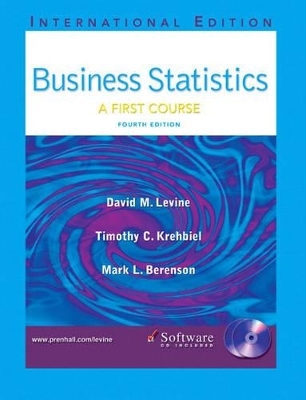
Business Statistics
Pearson
978-0-13-201648-3 (ISBN)
- Titel erscheint in neuer Auflage
- Artikel merken
A more comprehensive version by these same authors is also available called Basic Business Statistics 10e.
1. Introduction and Data Collection
Using Statistics: Good Tunes
Basic Concepts of Statistics. The Growth of Statistics and Information
Technology. How This Text Is Organized The Importance of Collecting Data.
Identifying Sources of Data. Types of Data.
2. Presenting Data in Tables and Charts
Using Statistics: Comparing the Performance of Mutual Funds
Tables and Charts for Categorical Data. Tables and Charts for Numerical Data.
Cross Tabulations. Scatter Diagrams and Time Series Plots. Misusing Graphs
and Ethical Issues
3. Numerical Descriptive Measures
Using Statistics: Comparing the Performance of Mutual Funds
Measures of Central Tendency, Variation, and Shape. Obtaining Descriptive
Summary Measures from a Population. Exploratory Data Analysis. The
Covariance and the Coefficient of Correlation. Pitfalls in Numerical
Descriptive Measures and Ethical Issues.
4. Basic Probability
Using Statistics: The Consumer Electronics Company
Basic Probability Concepts. Conditional Probability. Bayes’ Theorem. Counting
Rules. Ethical Issues and Probability.
5. Some Important Discrete Probability Distributions
Using Statistics: The Accounting Information System of the Saxon
Plumbing Company
The Probability Distribution for a Discrete Random Variable. Binomial Distribution.
Poisson Distribution. (CD-ROM Topic) The Hypergeometric Distribution.
6. The Normal Distribution and Other Continuous Distributions
Using Statistics: Download Time for a Web Site Home Page
The Normal Distribution. Evaluating the Normality Assumption. The Uniform
Distribution. The Exponential Distribution.
7. Sampling Distributions
Using Statistics: The Oxford Cereal Company Packaging Process
Sampling Distribution of the Mean. Sampling Distribution of the Proportion.
Types of Survey Sampling Methods. Evaluating Survey Worthiness.
8. Confidence Interval Estimation
Using Statistics: Auditing Invoices at the Saxon Plumbing Company
Confidence Interval Estimation of the Mean (s Known). Confidence Interval
Estimation of the Mean (s Unknown). Confidence Interval Estimation for the
Proportion. Determining Sample Size. Confidence Interval Estimation and
Ethical Issues.
9. Fundamentals of Hypothesis Testing
Using Statistics: The Oxford Cereal Company Packaging Process
Hypothesis-Testing Methodology. Z Test of Hypothesis for the Mean (s Known).
One-Tailed Tests. t Test of Hypothesis for the Mean (s Unknown). Z Test of
Hypothesis for the Proportion. Potential Hypothesis-Testing Pitfalls and Ethical
Issues.
10. Two Sample Tests using the Normaland t Distributions
Using Statistics: Comparing Sales from End-Aisle Displays and Normal
Displays
Comparing Two Independent Samples: Tests for Differences in Two Means.
Comparing Two Related Samples: Tests for the Mean Difference. Z Test for the
Difference between Two Proportions.
11. Chi-Square Tests and F Tests
Using Statistics: Guest satisfaction at T. C. Resort Properties
Chi-Square Test for Differences between Two Proportions. Chi-Square Test for
Differences in Among More than Two Proportions. Chi-Square Test of
Independence. Chi-Square Goodness of Fit Tests. F Test for Differences in Two
Variances. The Analysis of Variance (ANOVA).
12. Simple Linear Regression
Using Statistics: Forecasting Sales at the Sunflowers Clothing Stores
Correlation and Simple Linear Regression. Determining the Simple Linear
Regression Equation. Measures of Variation. Model Assumptions and Residual
Analysis. Measuring Autocorrelation: The Durbin-Watson Statistic. Inferences
Concerning the Slope. Estimation of Mean Values and Prediction of Individual
Values. Pitfalls in Regression and Ethical Issues. Computations in Simple
Linear Regression.
13. Multiple Regression
Using Statistics: Predicting OmniPower Sales
Developing the Multiple Regression Model. R2, adjusted R2, and the Overall F
test. Model Assumptions and Residual Analysis. Inferences Concerning the
Population Regression Coefficients. Using Dummy-Variables and Interaction
Terms in Regression Models. The Quadratic Regression Model.
Collinearity. Model Building. Pitfalls in Multiple Regression and Ethical Issues.
14. Statistical Applications in Quality and Productivity Management
Using Statistics: Service Quality at the Beachcomber Hotel
Total Quality Management. Six Sigma® Management. The Theory of Control
Charts. Control Chart for the Proportion of Nonconforming Items–The p Chart.
The Red Bead Experiment: Understanding Process Variability. Control Charts
for the Range and the Mean.
Answers to Self —Test Problems
Answers to Even-Numbered Problems
Appendices
Index
CD-ROM TOPICS
Chapter Sections
| Erscheint lt. Verlag | 5.5.2005 |
|---|---|
| Sprache | englisch |
| Maße | 214 x 277 mm |
| Gewicht | 1316 g |
| Themenwelt | Mathematik / Informatik ► Mathematik ► Finanz- / Wirtschaftsmathematik |
| Mathematik / Informatik ► Mathematik ► Statistik | |
| ISBN-10 | 0-13-201648-6 / 0132016486 |
| ISBN-13 | 978-0-13-201648-3 / 9780132016483 |
| Zustand | Neuware |
| Haben Sie eine Frage zum Produkt? |
aus dem Bereich


